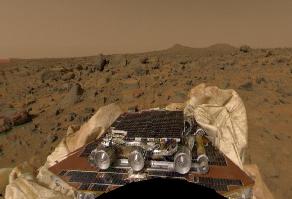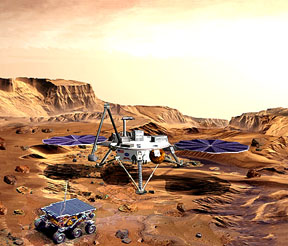This is an artist's depiction of the Mars 2003 rover and lander.
Click on image for full size
Courtesy of NASA
NASA Will Roam Around Mars with Rover
News story originally written on August 5, 2000
NASA has announced the next mission to visit the planet Mars. The Mars
Exploration Program Rover will start its journey in 2003 and should reach the
Red Planet in 2004. This rover will be a more advanced Sojourner Rover, which
visited Mars in 1997, as part of the Pathfinder mission.
The rover mission was chosen over an orbiter mission. The rover will land on the planet
and search around for evidence of water. The orbiter would have stayed in space while
imaging Mars. Either mission will greatly increase our knowledge of Earth's neighbor.
Now that the rover mission was chosen, scientists must decide if one or two rovers will be
sent.
"We are evaluating the implications of a two-rover option,"
Dr. Weiler said. Dr. Weiler is the scientist that made the decision. "I intend to make a decision in the next few weeks so
that, if the decision is to proceed with two rovers, we can meet
the development schedule for a 2003 launch."
Scientists are very excited about this newest rover. Sojourner was only able to travel
100 meters over its entire mission. But the new rover will travel 100 meters each day.
We will now study a lot more of the Mars surface and will hopefully find evidence that
water once existed on Mars.
You might also be interested in:

The Mars Pathfinder (MPF) mission was sent to investigate the geology of Mars. Its principal objective was to analyze the rocks and soil of Mars. The MPF consisted of 2 components, a lander and a mobile
...more
It was another exciting and frustrating year for the space science program. It seemed that every step forward led to one backwards. Either way, NASA led the way to a great century of discovery. Unfortunately,
...more
The Space Shuttle Discovery lifted off from Kennedy Space Center at 2:19 p.m. EST, October 29th. The sky was clear and the weather was great as Discovery took 8 1/2 minutes to reach orbit for the Unitied
...more
A moon was discovered orbiting the asteroid, Eugenia. This is only the second time in history that a satellite has been seen circling an asteroid. A special mirror allowed scientists to find the moon
...more
Will Russia ever put the service module for the International Space Station in space? NASA officials are demanding an answer from the Russian government. The necessary service module is currently waiting
...more
During a period of about two days in early May, 1998, the ACE spacecraft was immersed in plasma associated with a coronal mass ejection (CME). The SWICS instrument on ACE, which determines unambiguously
...more
J.S. Maini of the Canadian Forest Service has referred to forests as the "heart and lungs of the world." Forests reduce soil erosion, maintain water quality, contribute to atmospheric humidity and cloud
...more















